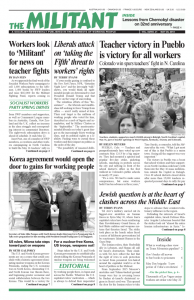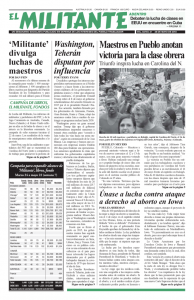Tel Aviv’s military carried out its biggest-ever airstrikes on Iranian forces in Syria May 10, where Iran’s capitalist rulers have been reinforcing their Revolutionary Guard forces, allied Shiite militias and weapons systems that threaten Israel. The strike took place as the Israeli rulers faced a series of deliberate provocations led by reactionary Islamist Hamas in the Gaza Strip.
The Iranian rulers, their Hezbollah ally in Lebanon, and Hamas all call for Israel’s destruction. Their clashes with Tel Aviv reflect the fact that the right of Jews to seek protection in Israel from persistent Jew-hatred around the capitalist world is at the heart of politics in the Mideast.
From September 2015 Moscow’s airstrikes and Tehran-backed ground troops were key in reversing losses by Bashar al-Assad’s dictatorial regime in Syria’s civil war. This opened the door for the Iranian rulers to take steps to advance their counterrevolutionary influence in the region.
Defending the interests of Israel’s capitalist rulers, Israeli Defense Minister Avigdor Lieberman boasted that the strikes took out “almost the entire Iranian infrastructure in Syria.” Israeli military sources said their warplanes struck Tehran’s munitions warehouses, intelligence sites and observation posts. The assault came after a failed rocket attack launched by Tehran from Syria on targets in the Israeli-occupied Golan Heights. The Israeli military also struck several Syrian aerial defense systems after Assad’s army tried to shoot down Tel Aviv’s missiles.
Moscow stood aside as Tel Aviv targeted Tehran’s bases. Immediately prior to their airstrikes, Israeli Prime Minister Benjamin Netanyahu flew to Moscow for talks with Russian President Vladimir Putin.
Moscow wants to protect its growing military and political influence in the Middle East, making its two military bases in Syria permanent. Tel Aviv made sure its airstrikes did no damage to Russian forces. Putin agreed to shelve its threat to supply S-300 anti-aircraft units to Assad. These could have assisted the Syrian regime in protecting Tehran’s forces from Israeli airstrikes.
Through its role defending the Assad regime, as well as advances Tehran made in Iraq through use of Shiite militias it controls there, Iran’s capitalist rulers are seeking to consolidate connections through those two countries to Hezbollah in Lebanon. They are also backing the Houthis in their war with the government in Yemen and its Saudi and U.S. allies.
Iran’s capitalist rulers have been looking to expand their reach for decades, to extend across the region the counterrevolution they carried through against working people at home.
Beginning in the early 1980s they turned back deep gains made by workers, farmers, women and oppressed nationalities following the massive popular uprising in 1979 that overthrew the hated tyranny of the U.S.-backed shah of Iran.
Iran’s ruling clerics failed to extend their influence over the Iraqi government in the May 12 parliamentary elections there. The slate backed by Muqtada al-Sadr, one of the few Shiite leaders to distance himself from Tehran, came in first. It had the backing of Iraq’s Communist Party. Sadr has also opposed Washington’s presence in Iraq.
Shiite militia leader Hadi al-Amiri’s bloc, which is backed by the Iranian rulers, came in second. Current Prime Minister Haider al-Abadi’s ticket, which had been favored to win, was third. Turnout was below 50 percent. Sadr supporters took to the streets in Baghdad chanting, “Iran out!”
For its own imperialist interests, Washington is pushing back against Tehran. The White House announced May 8 that it’s pulling out of the pact it had signed — along with the governments of the U.K., France, Germany, Russia and China — to restrict Iran’s nuclear program. White House National Security Adviser John Bolton reiterated May 13 that Washington’s capitalist rivals in Europe would face sanctions if they trade with Iran. Washington’s sanctions, which will fall hardest on working people, are due to be reimposed beginning Aug. 6.
Hamas, which governs Gaza, led Palestinian protesters into provocative attacks on the Israeli border. Tel Aviv’s response was predictably lethal, shooting dead at least 55 demonstrators and wounding hundreds more May 14. The Palestinian turnout was boosted because Hamas closed schools and workplaces that day.
Hamas organizers misled protesters, claiming over loudspeakers that Israeli soldiers were fleeing their positions when in fact they were reinforcing them. This led the protesters to rush the border where they found themselves facing Israeli soldiers with guns. Hamas members in the crowd targeted the soldiers with slingshots, rocks, and kites loaded with Molotov cocktails.
For years Hamas has staged actions aimed at drawing the Israeli rulers’ fire with deadly consequences for Palestinian toilers. Hamas’ strategy is to create Palestinian “martyrs” to gain sympathy in sections of bourgeois public opinion. They got the desired response from the liberal editors of papers like the New York Times and Daily News.
Hamas co-founder Mahmoud al-Zahar has said that the group’s goal is “removing the Jews” from the Middle East and urged followers to “kill them wherever you may find them.”
US rulers seek Israel, Palestinian peace pact
Washington opened its new embassy in east Jerusalem May 14. Days before, the State Department said the U.S. government does not consider the boundaries of Israeli sovereignty in Jerusalem a settled matter, leaving open prospects for further negotiations with Palestinian leaders, including on having the capital of a Palestinian state located there.
A Dec. 11 statement by the Socialist Workers Party — “For Recognition of a Palestinian State and of Israel” — explains such negotiations “must recognize the right of Jews everywhere to take refuge in Israel in face of the global rise of Jew-hatred and anti-Semitic violence, as well as the unconditional right of the dispossessed Palestinian people to a contiguous, sovereign homeland on territory — including east Jerusalem — conquered and occupied by the Israeli government during the 1967 war.”
The starting point for the SWP, the statement explains, is “the class interests and solidarity of workers and toiling farmers across the Middle East — be they Palestinian, Jewish, Arab, Kurdish, Turkish, Persian or otherwise, and whatever their religion or beliefs — as well as working people in the United States and around the world.”

